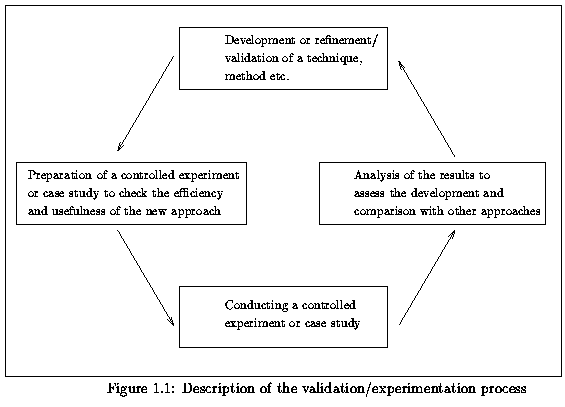



Next: Separation of Reading
Up: Introduction to the Experiment
Previous: Introduction to the Experiment
Research in computer science often involves the development of
new systems, methods and techniques in order to solve problems. However, once
developed there exists little experimental data to demonstrate
the usefulness of the new approach. In many cases no comparison
is made between a new development and the state of the practice.
Although the new development could be very useful, it may not be
transferred to industry since companies find it risky, time-consuming and
expensive to introduce
new technologies. There are always problems in the transfer of
knowledge from science to
industry but it becomes even more difficult without any
experimental data.
The question is how to get valid experimental data.
Even for scientists this doesn't seem to be a non-trivial task.
There are several reasons for this:
- There is no generally accepted method or process for conducting
experiments in software engineering in order to get valid data although a lot of work
has been done in recent years. Proposals for how to conduct
experiments are given in [BSH86] and [Sel92].
- There are a lot of aspects which must be kept
in mind when conducting an experiment.
If one important parameter is not
taken into account, the results can be completely wrong.
- At the moment computer scientists develop new techniques
and methods proposing that they are useful and better than
others. They don't provide any (qualitative or quantitative)
data that support whether their new technique or method is
effective. From a scientist' point of view there
seems to be no reason to conduct experiments with students or
in industry to gather data.
The result is that the new development is either not used
in industry or that it is used without knowing the risks and
problems (Then a project is the experiment/case study).
- Conducting an experiment to get valid data is
expensive. It takes a lot of time and effort for both the participant
and the experimenter.
- Students don't learn how to assess new techniques because they
don't know how to do experiments. That is
directly linked to the problem that many software engineers
themselves are not familiar with how to establish or evaluate a proper
experimental design [FPG94].
- The lack of metrics in the area of software development
makes it difficult to conduct experiments. If you want to
perform an experiment you will have to think carefully
about the things
you really want to measure and the metrics you want to use.
To sum up, much more experimental work must be done to move software
engineering from a craft to an engineering discipline.
To bridge the gap between software development and software
engineering, scientists have to check the usefulness of their
developments via experiments or case studies.
This lab package has three major objectives:
- Description of a particular technique to study,
perspective-based reading.
- Documentation of the way a particular controlled
experiment was prepared,
conducted and analyzed in order to discuss various
issues in experimentation.
- Explanation of the experiment to make it
understandable and repeatable for
other researchers.
The following research framework (which is an instance of the Quality Improvement
Paradigm [Bas93a]) was used throughout this work:

The process starts with the development of a new technique or method.
This section describes the Perspective-Based Reading technique as well as the
experimental context within which it is situated.
The next step is a
controlled experiment or case study to validate the new technique or method.
We include our experimental design in this lab package, as well as allow our
experimental materials to be downloaded, in the hope that other researchers
will be motivated to undertake replications of our experiment in other
environments.
Finally, the data is analyzed and interpreted. We provide our analysis
techniques and tools for other researchers. We also hope to maintain here a
history of replications of this experiment, so that general conclusions about
PBR may be drawn and the impact of environmental factors studied.




Next: Separation of Reading
Up: Introduction to the Experiment
Previous: Introduction to the Experiment
Generated by latex2html-95.1
Mon Jun 24 13:58:35 EDT 1996
Web Accessibility

